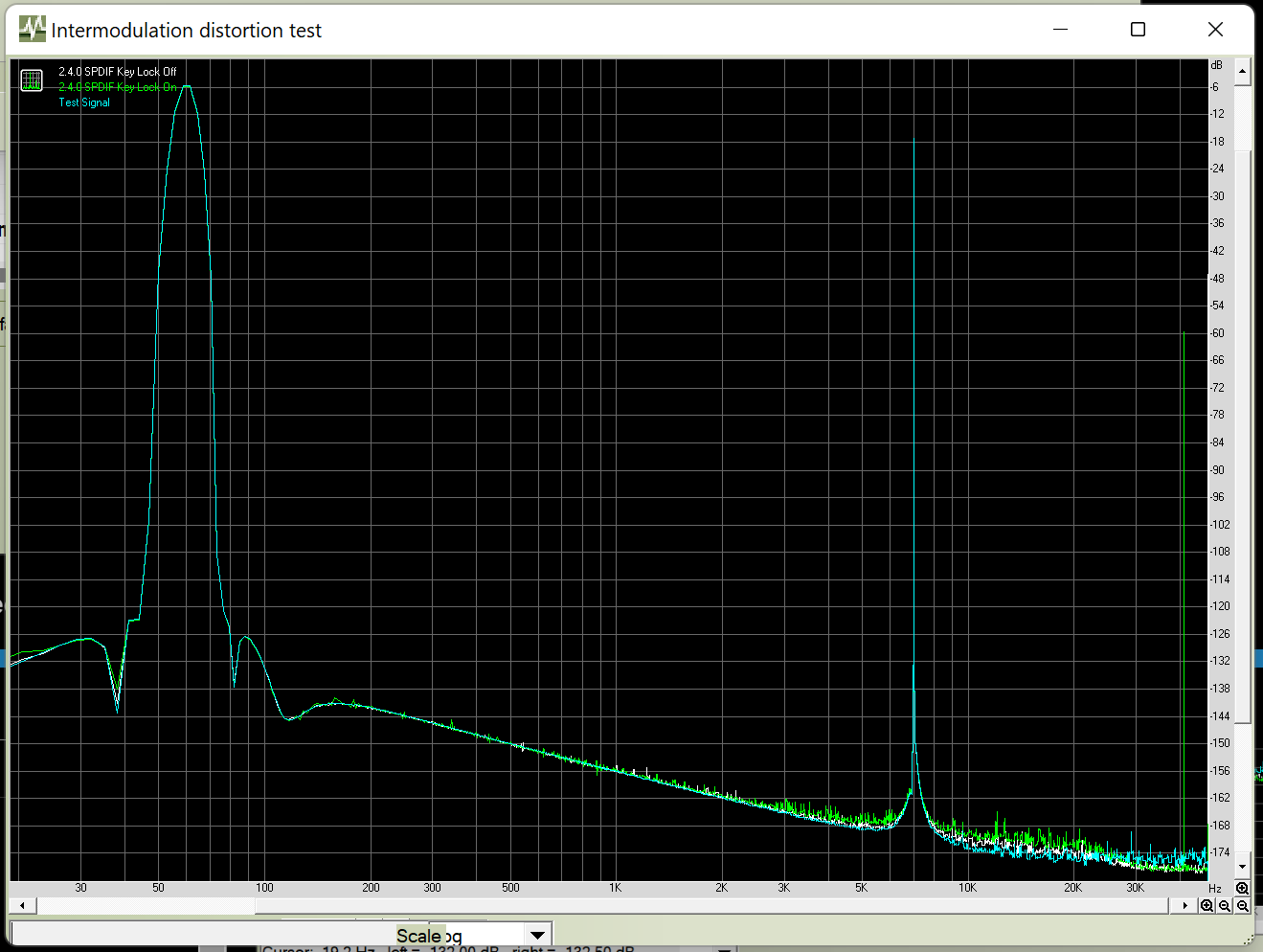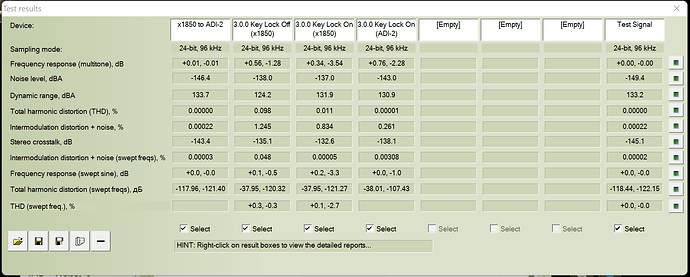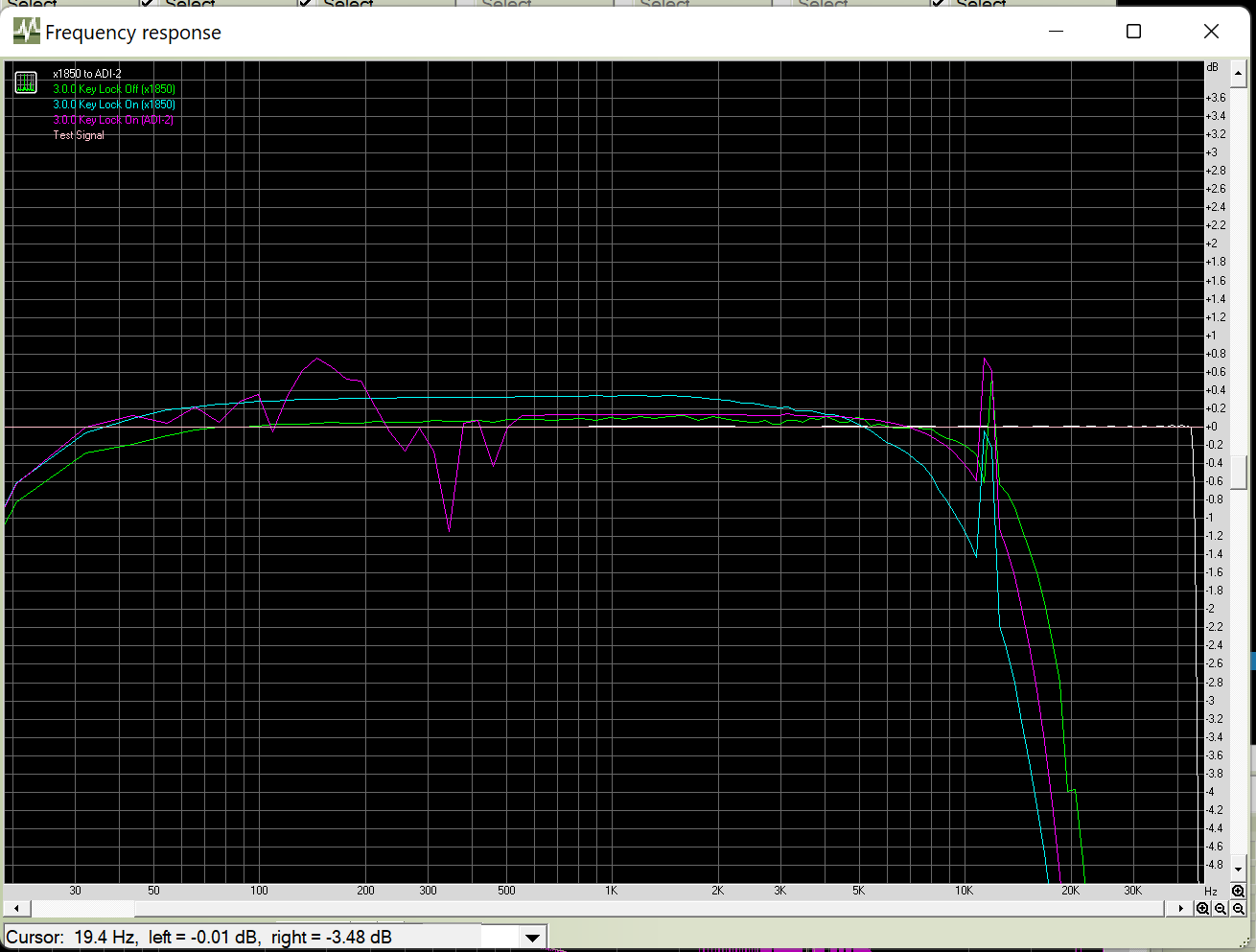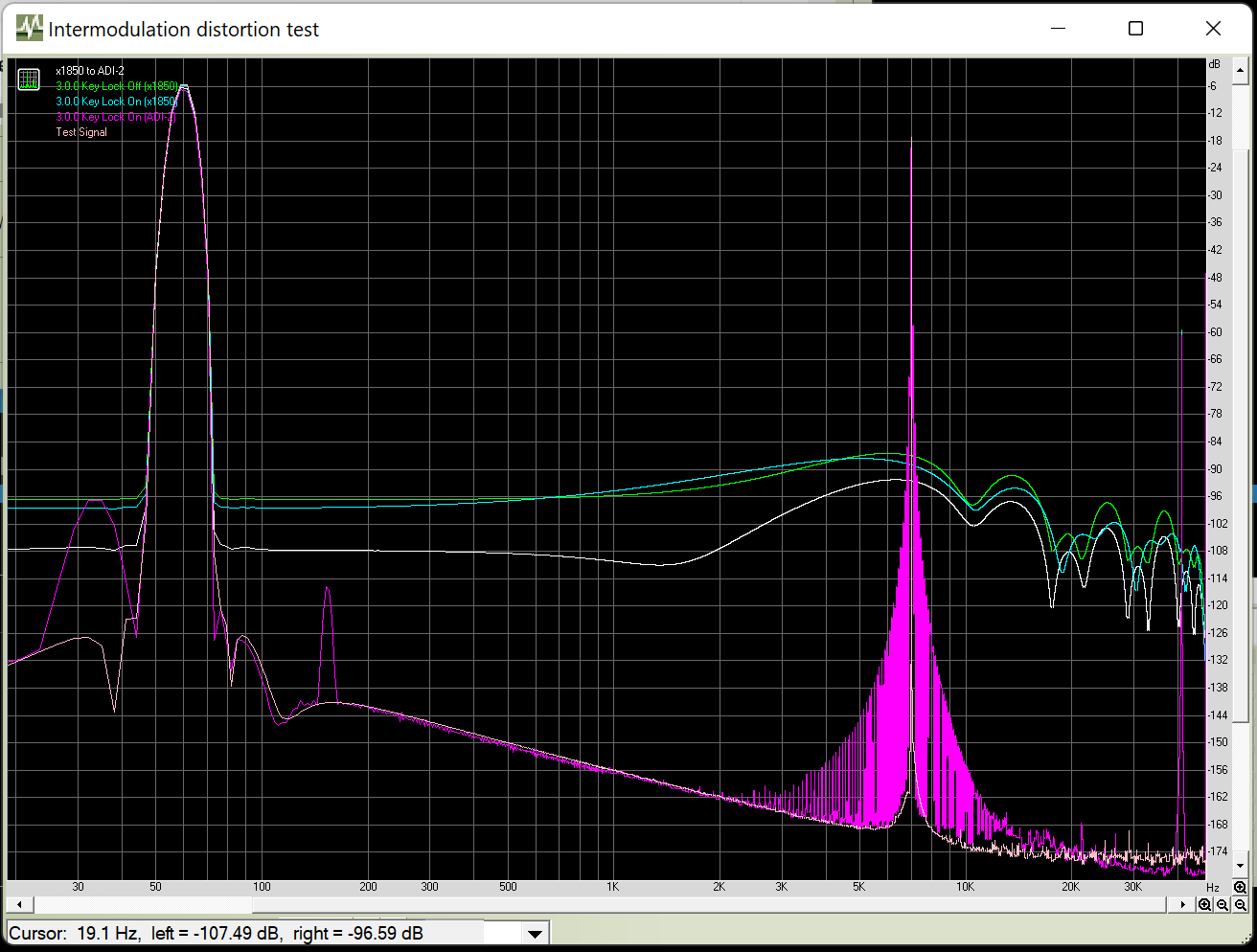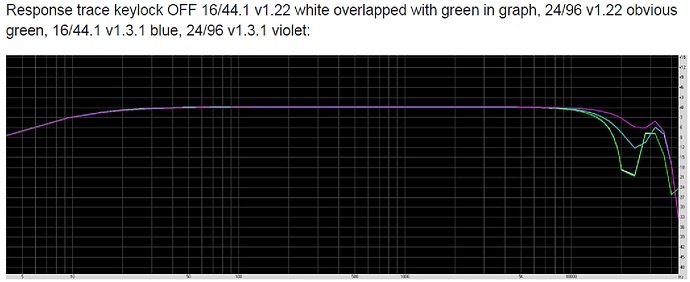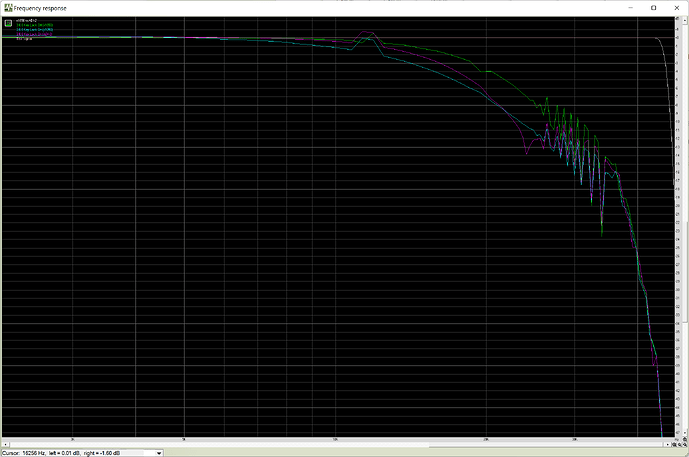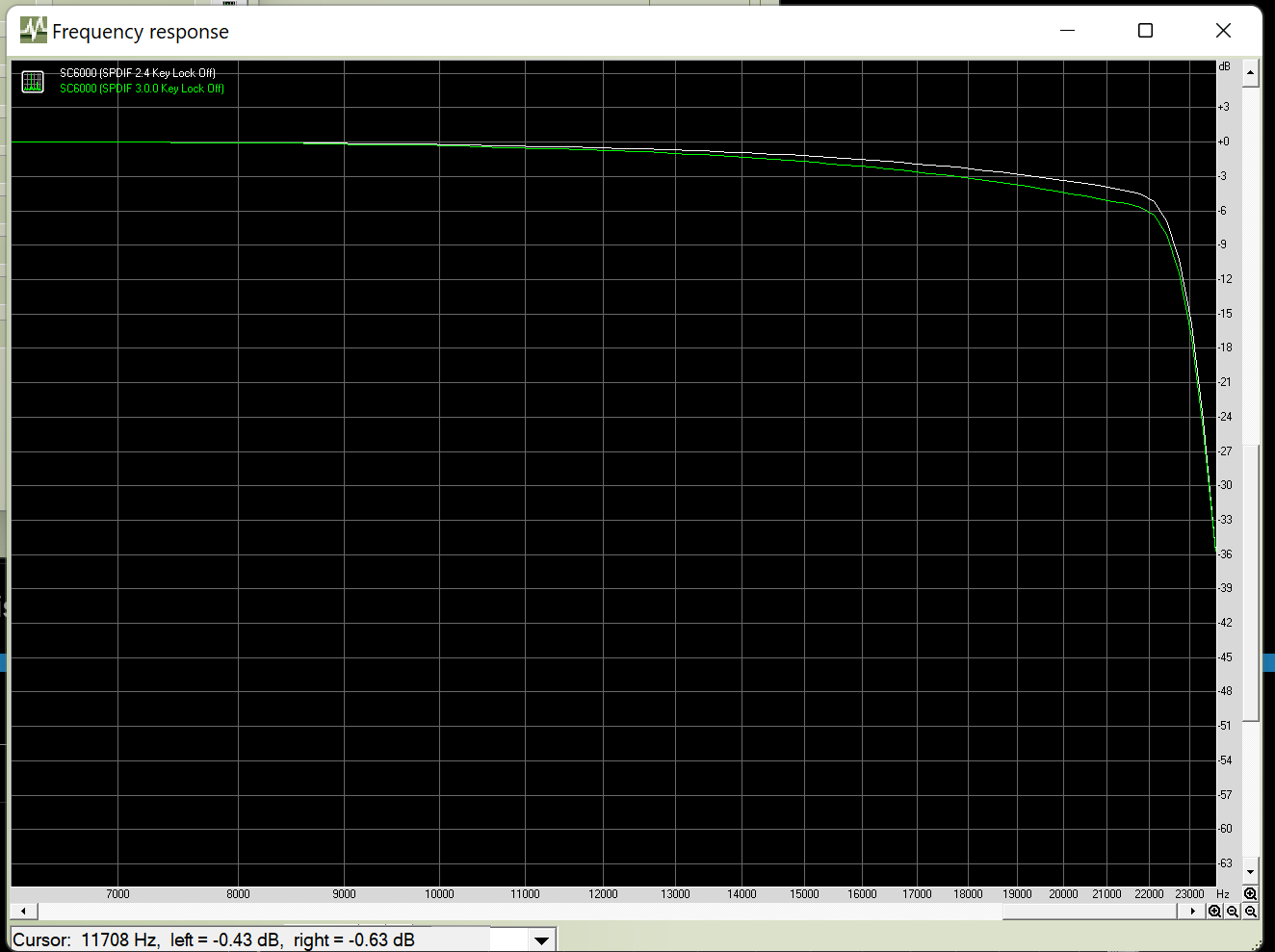I’m having sound issues on my prime 2
InMusic is apparently tracking this thread/bug already. So, probably no point in doing another bug report unless they ask for one.
Maybe they should pay you both as audio engineers as they, apparently, don’t have any on the payroll.
Weirder results… Test signal 96 kHz 24-bit. The player is connected directly to the RME ADI-2 via SPDIF.
v3.0.0
v2.4.0
They now had Luis Serrano Cavero from Kontrol DJ and ImageLine the last I knew with the Gibson acquisition. He designed some of my favorite old stuff. I’m not sure what they’ve got him working on, though, if he’s still with InMusic.
Make sure you also do a loop through not just in-situ within RMAA (the listed test signal in the numeric results) but either through and back into the RME or, better yet, from the mixer and into the RME.
While the frequency response in the audible range is much worse, which was obviously ridiculous to begin with for 96khz, and there’s still both IMD with keylock on at zero pitch and appalling THD during the sine sweep, that’s much less ultrasonic noise of late on both firmwares for some reason. I wonder if they’ve been altering the sound processing without telling us. They’d previously said they would only release changes to the core Prime DSP playback fidelity after saying so, that way we could listen and test for the changes. I get accidents, but there looks to have been secret changes already in 2.4 if I’m not mistaken. Or perhaps we’re just seeing the effects of newer hardware builds with much less jitter? PWM power supply noise certainly wouldn’t cause ultrasonic noise on SPDIF data.
RMAA is not perfect, though, so that’s why I’m talking about trying loop backs through gear of known performance like the mixer and RME interface itself.
I tried to record the signal in the same mode in which the player’s digital output works and so that the mixer’s DSP does not affect the result. In this case, I trust the RME device more than the mixer. But I will try to use the mixer as an interface. Perhaps the result was affected by the SteadyClock FS (lowest jitter and highest jitter immunity) that RME use
I don’t mean the mixer as the USB record interface being fed the players that are running the test signal, though you could do that for the heck of it. The mixer USB in to USB out for RMAA tests pretty great, though obviously not perfect. HiFi that I could tell, though.
I meant the computer running test signal → mixer playing from the USB → mixer SPDIF out → into RME SPDIF in, as if the mixer was the playback device if possible. Unless you’ve got some other SPDIF-equipped playback device you can compare the SC Prime players to. It should test great with the mixer as the player, but not as perfect as the raw in-situ test signal inside RMAA that you’ve already done. At the very least, out the RME SPDIF and back into its own SPDIF in like I’ve done on my Tascam to ensure I get similar results as the in-situ raw test signal evaluated by RMAA directly.
Oh you might also want to try TruRTA and some test waveforms: impulse, square, saw, etc, though if you just record the tests in a wave editor you can look at them directly that way, too, afterwards.
Mixer was in 96khz and so was OS & RMAA? Mixer almost looks like it’s doing SRC or got something’s turned on. The tone knobs were zeroed, right? You have your master and effects limiters off?
Edit: Oh, maybe that’s the other IMD test. Regardless, the mixer noise is still way down.
Frequency response and IMD+Noise % (not the swept one) seem to be the important areas to watch on these still.
Yes, everything worked in 96k 24-bit mode. All knobs are set to 0, i think nothing extra is turned on. fx limiter was on, master limiter off. This result seems strange to me too.
Yeah, I don’t get why the signal from the players would get so much more IMD into the mixer, though it’s still pretty low near the noise floor. Is that the swept frequencies IMD test you posted the graph for? Was there a graph for the IMD + Noise that’s 6th from top?
the last graph is IMD + Noise, %
Hmm… well, I guess if you’ve already got a lot of IMD (from the players’ processing) and you put it through a device that’s good but not perfect like this mixer, I suppose it makes sense it’s going to muss it up a little even further. I’m almost wondering now how well the X1850 would do instead of using the USB from the computer, using the SPDIF from your reference interface, go SPDIF into the mixer, and then SPDIF out from mixer back into the interface. I’m slightly wondering if something weird’s going on with the mixer SPDIFs, in addition to the players.
Also, I’m still mystified how sharp your roll off is and the lack of ultrasonic junk.
Can you repost zoomed out more on your frequency responses? And/or scroll down so we see down past -10dB out to past 30khz. Sorry to be a pest.
So, even bypassing the mixer and sending the player directly into your RME ADI interface with SPDIF at 96khz, there’s no ultrasonic noise? This definitely looks like a more aggressive (or at least competent past the corner frequency) anti-aliasing filter, and yet still has a lot of IMD + noise from the players… maybe from early stages of SRC or other processing before it’s getting this last filter stage.
What sample rate is the RMAA test file you’re playing on the SC6000?
I used 96 kHz 24-bit test signal file…
Ok. Gosh, that’s a nutty amount of roll off for a 96khz file. There clearly is distortion going on at around 30khz, but it’s not rising up like on my tests.
H̶a̶v̶e̶ y̶o̶u̶ t̶r̶i̶e̶d̶ a̶ 4̶4̶.1̶k̶h̶z̶ R̶M̶A̶A̶ t̶e̶s̶t̶ t̶r̶a̶c̶k̶ t̶h̶a̶t̶ y̶o̶u̶ g̶e̶n̶e̶r̶a̶t̶e̶d̶ a̶n̶d̶ p̶l̶a̶y̶e̶d̶ f̶r̶o̶m̶ t̶h̶e̶ S̶C̶6̶0̶0̶0̶ b̶y̶ S̶P̶D̶I̶F̶ i̶n̶t̶o̶ t̶h̶e̶ R̶M̶E̶ A̶D̶I̶, w̶i̶t̶h̶ a̶l̶l̶ t̶h̶e̶ i̶n̶p̶u̶t̶ S̶P̶D̶I̶F̶ &̶ O̶S̶ r̶u̶n̶n̶i̶n̶g̶ a̶t̶ 9̶6̶k̶h̶z̶?̶
Edit: I see you already did 44.1khz RMAA test tracks 6hrs ago. My remaining curiosity is what those test tracks look like way out to 30khz down below -10dB. Did you save those results you can pull up again and zoom out and/or scroll down?
They are definitely using a steeper filter on 3.0.0 for SC6000 than on 1.3.1 for SC5000 that effectively removes the ultrasonic noise, but yet still have an IMD problem with 44.1khz being resampled, and also with 96khz tracks when Elastique is on even at zero pitch. Your new noise is obviously bad, as are the new response anomalies, but they’re clearly trying to deal with the ultrasonic noise problem, even if they haven’t told us about implementing new audio processing changes on the players. There’s something positive to be gleaned out of this.
My suspicion is that they 1) changed the final anti-aliasing filtering they’re doing, even though they’re not seemingly changing it much from rate to rate, and 2) they’re not doing as much sample rate conversion anymore on 96khz, which would account for the sudden reduction of IMD on 96khz tracks processed at 96khz without keylock. Before they may have been SRCing everything, including 96khz, to a wild oversample, and then everything back down. Now, 96khz material seems to be a little more hands-off. Honestly, it should have been like that to begin with, and not being like that was kind of weird because they said that was the rate the players and SPDIF out all ran at.
Clearly, they’ve got some response issues still that have only been exacerbated, a spurious noise issue in the audible band you’re hearing on some models, and the IMD issue will continue to be a problem for every rate other than 96khz even with keylock off. My hunch is that they may be working gradually towards allowing us to choose the rate the players run at, so we can match the player rate to most of our files to improve the sound quality like I previously asked. In the meantime, prior to that, their filtering needs work, and they need to figure out why Elastique is causing issues with IMD, and, most importantly in the short term, figure out this new spurious noise.
I would be interested to see for 3.0.0 both 44.1khz and 96khz test sweeps like I did in my video to see how much additional harmonics occur on a spectrograph. The one with Traktor and the SC5000 was a swept tone. The other video I did used the pitch fader with a 10khz tone. Obviously, you have to keep keylock off when you do that one, so you’re avoiding some of the SRC now apparently with the 96khz track. I suspect 96khz will have quieter distortion harmonics with keylock off than the other sample rates.




